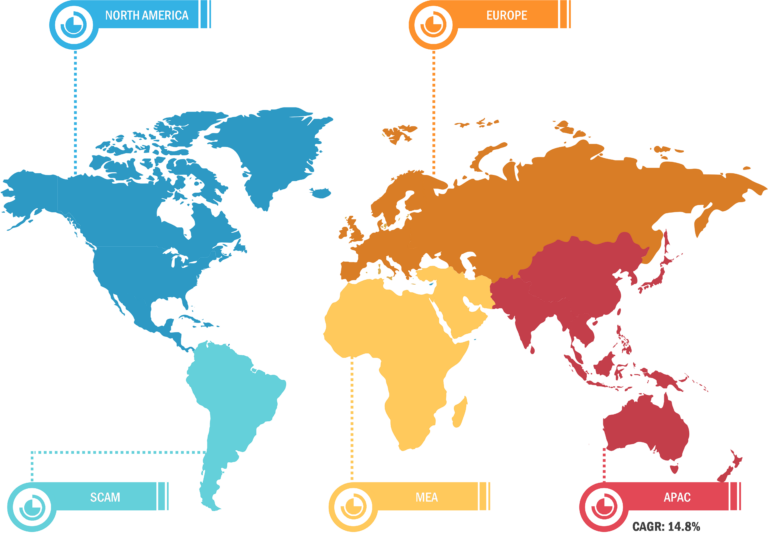
Artwork Management Software Market
The US, Canada, and Mexico are the major contributors to the North America artwork management software market. North America is one of the frontrunners in terms of developing and accepting new, advanced technologies. Packaging material design plays a crucial role in the pharmaceutical industry. Major pharmaceutical companies such as Pfizer, AbbVie, and Johnson & Johnson are investing heavily in product packaging to increase sales. Artwork management system plays a significant role in the packaging process. The software helps pharma manufacturers automate the entire process, from product designing to printing. According to International Quality and Value Institute Advisors (IQVIA), North America accounted for 49.1% of global pharmaceutical sales in 2021. Growing pharmaceutical sales in the region increase the demand for label and artwork management software and its adoption among pharma manufacturers, as it helps manufacturers simplify product packaging by reducing manual processes, boosting the artwork management software market growth.
The US and Canada are considered developed countries in terms of modern technologies, manufacturing, standard of living, infrastructure, etc. According to the National Association of Manufacturers, the US manufacturing sector was valued at ~US$ 2.5 trillion in 2021. The proliferation of this industry is mainly attributed to easy access to new technologies, rise in pharmaceutical manufacturing, reduced prices of gas, surge in labor costs in emerging markets, and better protection for intellectual property rights. The rising use of technologies in the last five years has fueled the adoption of packaging artwork management software in the region. In May 2022, IQVIA’s Migration Information and Data Analysis System (MIDAS) stated that the US accounted for 64.4% of sales of new medicines launched from 2016 to 2021. Also, Canada is becoming a more favorable country for manufacturing activities due to the availability of power at a lower cost, owing to advancements in the coal, metal, and oil industries.

Similarly, there is a rise in the adoption of cloud artwork management software in food & beverages manufacturing. For instance, manufacturers of granola bars in certain geographical areas can develop distinctive labels highlighting local ingredients such as maple syrup from Canada or honey from the US. Thus, the growing access to innovative technologies is transforming production processes along with enabling enterprises to reduce their production costs and time. Further, the manufacturing sector in Mexico is also witnessing significant growth due to government initiatives for attracting FDIs, its proximity to the US, and its ability to achieve cost-competitiveness with the support of the North American Free Trade Agreement (NAFTA). Such favorable growth prospects are encouraging businesses in the region to make high investments in automation, which supports the growth of the artwork management software market. Further, the presence of numerous artwork management solution providers boost the artwork management software market growth. A few of these companies are Perigord Life Science Solutions—a Tech Mahindra Company, Karomi Inc, and Loftware Inc.
US Dominates Artwork Management Software Market in North America
The US is one of the most prominent developed countries worldwide, with a high rate of technological adoption across all industries. The manufacturing sector in the country plays a significant role in the US economy. The country has a wide presence of diverse industries and is one of the world leaders in high-technology innovation, which further drives the adoption of automation technologies. The US also holds one of the world’s major pharmaceutical industries, with approximately one-third of the pharmaceutical market share globally. The growth in the pharmaceutical industry increases the adoption of artwork management software among pharmaceutical packagers. According to Atradius Collections, the US represents around 45% of the global pharmaceutical market with 22% of world production. Thus, the growing manufacturing and pharmaceutical industry across the region, coupled with their high adoption of technologies for automated production processes, contributes to the growth of the artwork management software market across the region.
Artwork Management Software Market: Segmental Overview
Based on deployment, the artwork management software market is segmented into:
- Cloud
- On-Premise
The cloud segment recorded a larger share of the artwork management software market in 2022 and is anticipated to register a higher CAGR during the forecast period.
Based on application, the artwork management software market is segmented into:
- Life Sciences
- Retail
- Manufacturing
- Others
The life sciences segment registered the largest share of the artwork management software market in 2022. The cloud segment is anticipated to record the highest CAGR during the forecast period.
Artwork Management Software Market Analysis: Competitive Landscape and Key Developments
enLabel Global Services Inc, Karomi Inc, Loftware Inc, Perigord Asset Holdings Ltd, Freyr LLC, Esko-Graphics BV, Pharmaceutical Design BV, GreatFour Systems Inc, Kallik Ltd, and Aptean Inc are among the key artwork management software market players that are profiled in the report. Several other essential artwork management software market players were analyzed for a holistic view of the market and its ecosystem. The market report provides detailed market insights to help major players strategize their growth.
- In November 2022, Teksana and Karomi Inc has formed a partnership to provide world-class technology and services to companies offering pharmaceutical, retail, and consumer products.
- In May 2022, Kallik and Aston University started a three-year Knowledge Transfer Partnership (KTP) to develop a proprietary machine learning model for Kallik’s labeling platform—Veraciti. This innovation aims to streamline label creation, ensuring 100% compliance with regulations. By incorporating advanced computer vision and AI, this collaboration will significantly benefit Kallik’s customers in regulated industries, reducing time-to-market and improving compliance. The partnership shows the way academia and industries can collaborate to enhance technology solutions.







